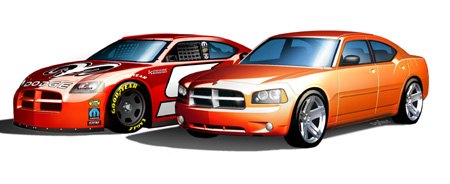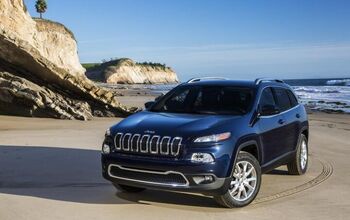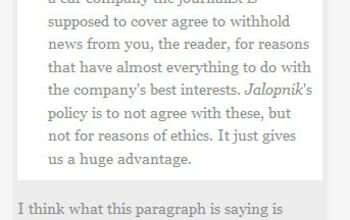Embargo This!
Before you read this editorial, you must first agree not to show it to anyone until next Tuesday. Yeah, right. And yet carmakers routinely provide new product news and photographs to the press subject to a mutually agreed release date. The industry calls the practice a "news embargo". It's the dirty little secret that lies at the heart of the relationship between automakers and the press.
It's easy to understand why automakers love a good embargo: a carefully-timed news blackout is the key to coordinating a vehicle's public debut– from tease to reveal to nationwide campaign. If the general public hears about a new car too early, the thrill of the new strangles the sales of the old. If an upcoming product's particulars arrive too late, valuable marketing momentum is lost. The news embargo significantly decreases the automakers' risk of blowing their big bucks product launches.
By their very nature, the news embargo also limits negative buzz. Think of it this way: if loose lips sink ships, an embargo can help keep a leaky ship afloat. Equally important, the blackout extends to "third parties", so the press can't reveal new model information to outside experts. When the embargo ends and the story breaks, the public receives only the manufacturer's details/photographs (along with a bit of editorially neutral background). Later, well, who cares? The damage has not been done.
Compare the early coverage given the new Dodge Charger with later, less widespread reports chronicling muscle car aficionados' outrage at the new Charger's four-door design. By sitting on Dodge's concept sketches as instructed, the automotive press helped guarantee a positive result for DCX, and a negative one for Charger purists.
Members of the motoring media perpetuate the embargo system because they figure if they don't play ball, they'll be locked out of the ballpark. This justification was brought into sharp focus last December. When embargoed pictures of the new Corvette Z06 suddenly appeared on-line, GM dispatched two Securitas goons to threaten an offending webmaster. Autoweek reported on the intimidation, ran the 'Vette pic, and clarified their position on news embargos: "We won't be the first to break an embargo, but neither will we be the last".
Of course, Autoweek and their ilk realize that the web threatens the status quo– even if dozens of websites responded to GM's threats by pulling the Z06 pictures off-line. While the mainstream automotive press is not about to tell carmakers to stick their news embargos up their figurative tail pipes, they're more than happy to let the newbies chip away at the system. Rest assured: if the new electronic media can get away with embargo running, the old guard will be right behind them; ready, willing and able to capitalize on their competitors' bravery.
Fortunately, the news embargo is under attack from other quarters. These days, scoop hunters like Brenda Priddy and John Johnson prowl the Las Vegas desert and German Nürburgring, capturing photos of future models. The publication of these spy shots, and the increasing use of Photoshop to generate computer models based the images, are positive signs that the automotive PR guys no longer call all the shots. But the corporate communicators are nothing if not resilient. They've responded to the sneak attacks with an advanced embargo technique called the "private press preview".
For example, a few months ago Saturn presented its upcoming models to selected automotive writers. Journalists emerged from the hush-hush happening suitably enthused about the company's new design and engineering direction. But an embargo left the hacks unable to talk about Saturn's future products in any detail– aside from the "happy days are here again" party line.
Although Saturn PR sold the embargoed event as background, it was clearly designed to stem the flood of criticism directed at GM's faltering division. And it worked; the debate about Saturn's tired product range has gone quiet. This despite the fact that there's no guarantee that the previewed cars will make it into production, or that they'll be any good if they do.
Of course, the news embargo only persists because it's a win – win situation for the players involved. The manufacturers get to manipulate the news, while the press knows they'll never be out of the loop. Equally important, by keeping more aggressive journalists away from the master's table, embargos perpetuate and maintain the power of the buff book boys' club.
The only real loser is the general public. News embargos restrict the free flow of timely, unbiased information. They also muddy the journalistic waters, denying interested enthusiasts a vigorously independent automotive press. To rectify the situation, all automotive publications should refuse to agree to any news embargo, no matter how tempting such 'scoop insurance' may be. It's our policy, and it should be theirs.
More by Robert Farago
Latest Car Reviews
Read moreLatest Product Reviews
Read moreRecent Comments
- Redapple2 Good luck to them. They used to make great cars. 510. 240Z, Sentra SE-R. Maxima. Frontier.
- Joe65688619 Under Ghosn they went through the same short-term bottom-line thinking that GM did in the 80s/90s, and they have not recovered say, to their heyday in the 50s and 60s in terms of market share and innovation. Poor design decisions (a CVT in their front-wheel drive "4-Door Sports Car", model overlap in a poorly performing segment (they never needed the Altima AND the Maxima...what they needed was one vehicle with different drivetrain, including hybrid, to compete with the Accord/Camry, and decontenting their vehicles: My 2012 QX56 (I know, not a Nissan, but the same holds for the Armada) had power rear windows in the cargo area that could vent, a glass hatch on the back door that could be opened separate from the whole liftgate (in such a tall vehicle, kinda essential if you have it in a garage and want to load the trunk without having to open the garage door to make room for the lift gate), a nice driver's side folding armrest, and a few other quality-of-life details absent from my 2018 QX80. In a competitive market this attention to detai is can be the differentiator that sell cars. Now they are caught in the middle of the market, competing more with Hyundai and Kia and selling discounted vehicles near the same price points, but losing money on them. They invested also invested a lot in niche platforms. The Leaf was one of the first full EVs, but never really evolved. They misjudged the market - luxury EVs are selling, small budget models not so much. Variable compression engines offering little in terms of real-world power or tech, let a lot of complexity that is leading to higher failure rates. Aside from the Z and GT-R (low volume models), not much forced induction (whether your a fan or not, look at what Honda did with the CR-V and Acura RDX - same chassis, slap a turbo on it, make it nicer inside, and now you can sell it as a semi-premium brand with higher markup). That said, I do believe they retain the technical and engineering capability to do far better. About time management realized they need to make smarter investments and understand their markets better.
- Kwik_Shift_Pro4X Off-road fluff on vehicles that should not be off road needs to die.
- Kwik_Shift_Pro4X Saw this posted on social media; “Just bought a 2023 Tundra with the 14" screen. Let my son borrow it for the afternoon, he connected his phone to listen to his iTunes.The next day my insurance company raised my rates and added my son to my policy. The email said that a private company showed that my son drove the vehicle. He already had his own vehicle that he was insuring.My insurance company demanded he give all his insurance info and some private info for proof. He declined for privacy reasons and my insurance cancelled my policy.These new vehicles with their tech are on condition that we give up our privacy to enter their world. It's not worth it people.”
- TheEndlessEnigma Poor planning here, dropping a Vinfast dealer in Pensacola FL is just not going to work. I love Pensacola and that part of the Gulf Coast, but that area is by no means an EV adoption demographic.





































Comments
Join the conversation